Rebecca Ashton sits in on a day with Stefan Wolff conducting a Clinic, she also took the pictures.
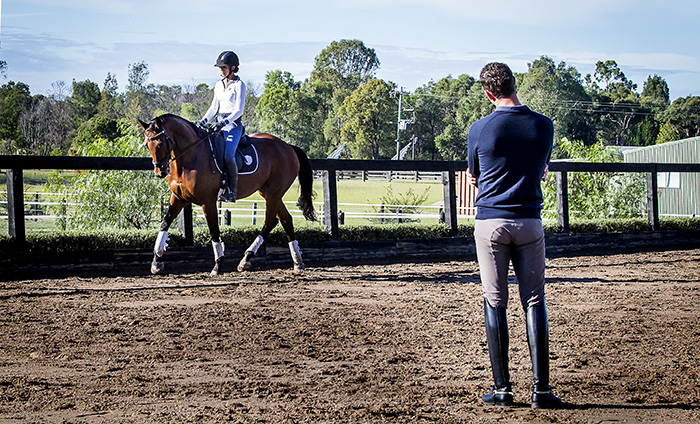
Having a knowledgeable German eye, like the Klaus Balkenhol-trained Stefan Wolff is worth a great deal. Stefan Wolff has: a good eye, a fabulous feel, and best of all, he has a wonderful ability to convey his message.
Grace Kay is a super rider. She’s been to Europe, and is smart enough be a regular at Stefan’s clinics. This morning she has a five-year-old in the arena, WG Confederate. The bay is well aware of his big movement, but can be a bit cheeky with it. Stefan explains, “He braces his back a little against the bit then his movement gets bigger and bigger and you can’t touch him anywhere; with your hand, with your leg. I want him to relax more around his wither, now I’m happy, he’s trotting a little smaller.”
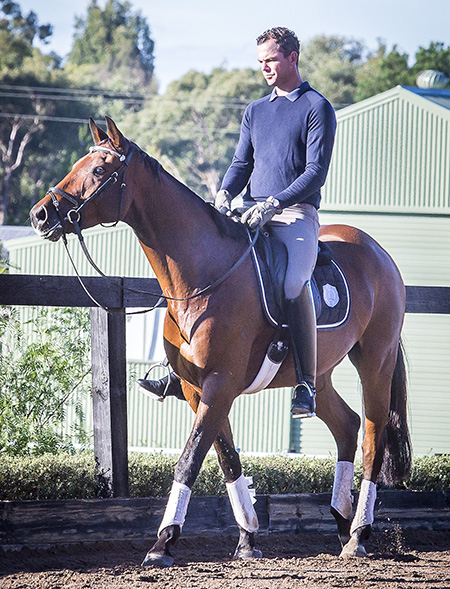
Stefan wants a feel, and jumps on board, working on suppling and relaxing the youngster.
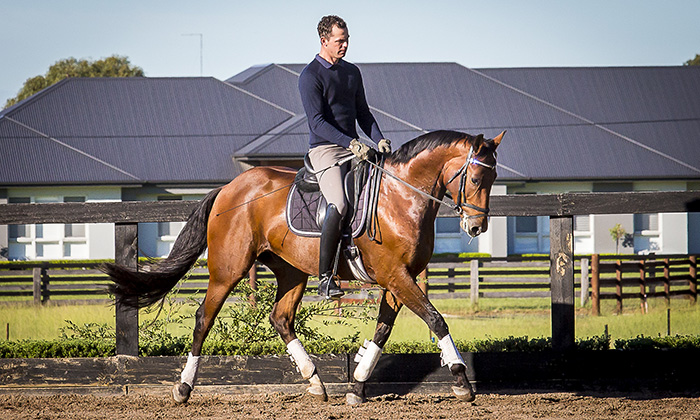
Bending lines, 15 metre circles, relaxed, smaller strides, counter flexion; getting the horse to relax the wither area. There are rein backs, quite a few steps, but steady and calm; this isn’t a punishment. Then just one step. He wasn’t to brace into the halt.
Grace is back on board and Stefan helps with the feel, “Try not to push too much. A little leg then just fall in there with your seat. It should feel like his withers drop a bit so it doesn’t push the shoulder away, but leaves the shoulder on the body.”
“Initially they’ll trot a little more ordinary. Let him fall into the bit. Good. When he can produce the contact through the shoulder, then you can go forward. You need the forward eventually. Every stride you want to feel like the spine drops a little. When he doesn’t brace, ride forward. Align him until everything falls into place.”
Stefan suggests that this might be a horse that goes better with two 20 minute sessions a day rather than one longer session. Stefan is solution-based in his training, and likes overcoming the different challenges each horse provides.
“It’s good that Grace has this horse. It’s a super horse.”
Next Stefan works with a more experienced horse
Grace’s friend, helper and owner Jo Keyte is riding San Andreas.
Jo is focusing on the contact with the big horse and after just a couple of lessons, Stefan is really happy with the progress. “Start with a few walk halt transitions. Every pull and resistance in the neck originates in the back so you have to get him active. Don’t be prone to use your hands. It’s one of those challenges we all have. The horse has to be active into the halt, not back off the walk into the halt. There’s your contact. The leg stays long, softer with the spur. Only use it when needed.”
Then it’s on to walk trot transitions. Andy is perhaps a little heavier in the hand than what would be considered perfect, but Stefan doesn’t mind because it’s, “…in a good way and this is good for him. There are many ways to soften. Remember when the horse is too strong, it’s not the mouth, it’s the back and shoulders.”
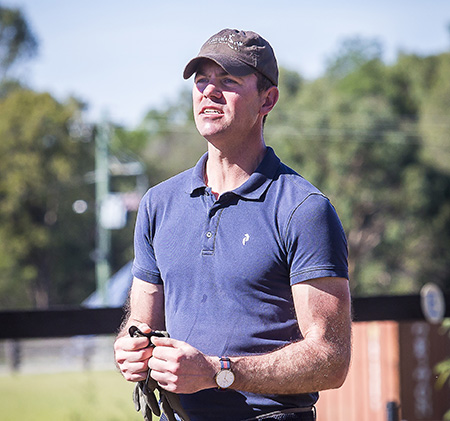
Next Stefan focuses on Jo, “Try and keep your hand lower. The poll is up, but you are holding him up there a bit. Make it a safe head carriage. Take your hand lower. The horse needs to lift into the contact. The poll should be higher than the hand. Confirm his stability and self-carriage by giving. Just follow forward with the hand. Trust him. Follow the crest to the mouth rather than throw away the contact.”
“Try to let the saddle keep you on the horse rather than your knees. Follow the movement with your body. Your hand receives so that means your body has to receive the movement as well, even your shoulders. Trust that things fall into place. Better. Now your seat has more flexibility.”
It’s time to get the big horse a little more active and Stefan explains the process and biomechanics of collection, “If you get more activity, he’ll be happy to come shorter because the activity creates self carriage. Don’t worry about making a mistake, as long as you realise what’s happened. Let him move. There’s room for more. Jawohl! Exactly. See that gives him more space, more room to supple the muscles. Allow him to come higher and move.”
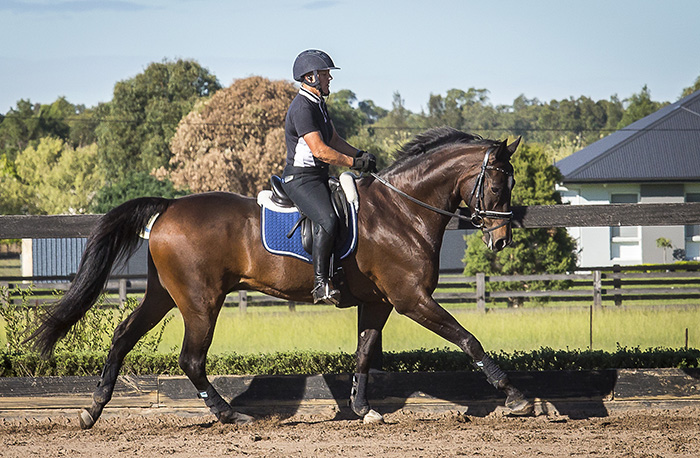
Then the canter,“Little shorter rein now. As you went into canter, his first desire was to brace with the under neck, so instead lift it a bit up and that way you get the top line to work and the under neck to relax. You want the under neck to be slimmer, and the top line wider…”
“Now 20 metre circle and we try to collect him a bit, but only if you can keep a safe self-carriage and activity. Low hand, sit tall. Now 10 metre circle on the long side. Quick; not fast, but quick mobility of his legs. Keep your aids a little bit alive. If he braces for a few strides don’t change your aid, don’t worry ,just wait. Little bit of counter canter. Ja! feel that? It gets better and better.”
“The same is true for the trot transition. Don’t hold in the transition. Make it a constructive aid, a constructive moment, not holding your breath and hoping it works! Good work today!”
“Don’t worry about the first fussiness from the horse when you’re doing something new. He’s really doing good work. Not too contained. Move it. If you ride in collected ways, everything actually becomes more, not less. That’s why dressage isn’t boring! There becomes a larger range not a smaller range.”
“Close your fist and get him to come up to you, not hold against you. It’s all about improving the working paces first. It’s easier to collect a horse from the working paces.”
The flexion just needs a slight adjustment to keep the quality of the work and you realise how connected everything is, “Don’t flex down, flex in front of you. Keep him in front of you for the flexion. And now your sitting gets better. Your body comes to a more upright position.”
“Smaller canter circle. That’s a bit too much flexion then he drops again. Shorter rein. Now he lifts his neck into the contact. Let him come back, play a little bit with him, keep him a little busy, look ahead and feel.”
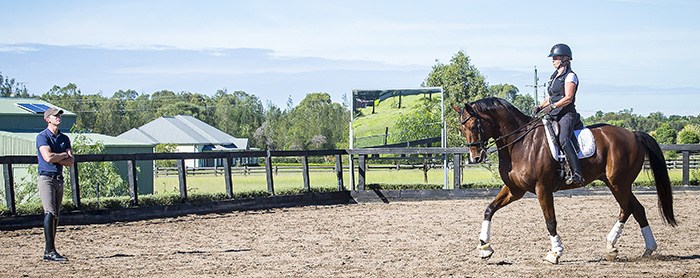
Caroline Hooper is a long time student of Stefan and Becks Gold is really coming along, “When you use the whip, he should get softer not more tense. If you use the whip, use it just behind your heel. Don’t get stuck with your contact. Good. That’s right. Move. Don’t slow down in the trot. Keep him in front of you in the half halt. Don’t be pushy, just busy with your leg. Get him moving and suppling under you, not pressing forward.”
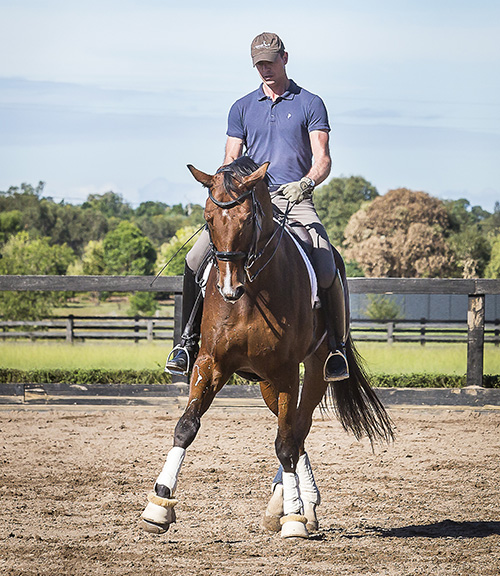
Stefan jumps aboard for a feel. Small turns,10 metre serpentines, leg yield, suppling, moving the back, moving the hindlegs, getting the horse soft under him, listening, reactive and really accepting the aids.
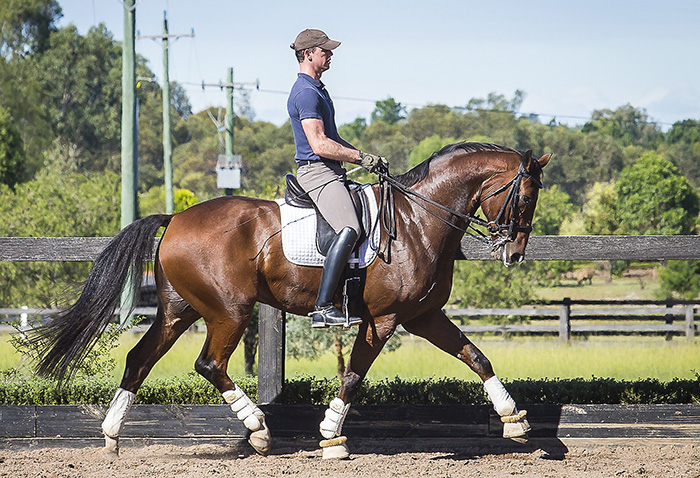
It’s Caroline’s turn to finish, “In the half halt, feel his back come to your butt. Your driving aid needs to know exactly what it wants. You cannot just give random driving aids. Shoulder in then half pass. Keep riding. Let him move. That’s better. Let the poll come up.”
The session, like the last also finishes with a little look at the working pirouettes. “He needs to keep working with your aids and not die under you. Keep the outside shoulder. Give him something to focus on. The outside shoulder needs to come back to you and turn into you. When he starts turning the pressure on the body gets higher so you want him to just keep working with you. Just play and keep riding. Exactly!”
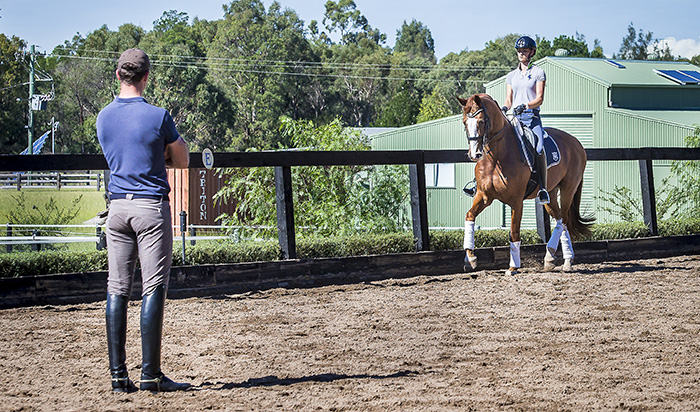
Sally Rizzuto has only recently taken over the ride of Diamond Star. It’s a big step for a young rider who beforehand had only competed to Advanced, but Sally is smart, a fast learner and taking the new Grand Prix challenge in her stride. She’s got the chestnut trotting around, stretching on a long rein. Stefan is impressed, “It’s good to see you’ve started with what we were talking about the other day. Everything you should be able to do on the long rein in working trot. He’s now moving from your leg and through the bridle not holding against your leg. Practice, practice, practice until it becomes part of the motion memory. We don’t want it bouncier. When you bring the horse back, you want him to keep motoring on and in front of you so he’s always in front of the leg. Then it’s easier in the test.
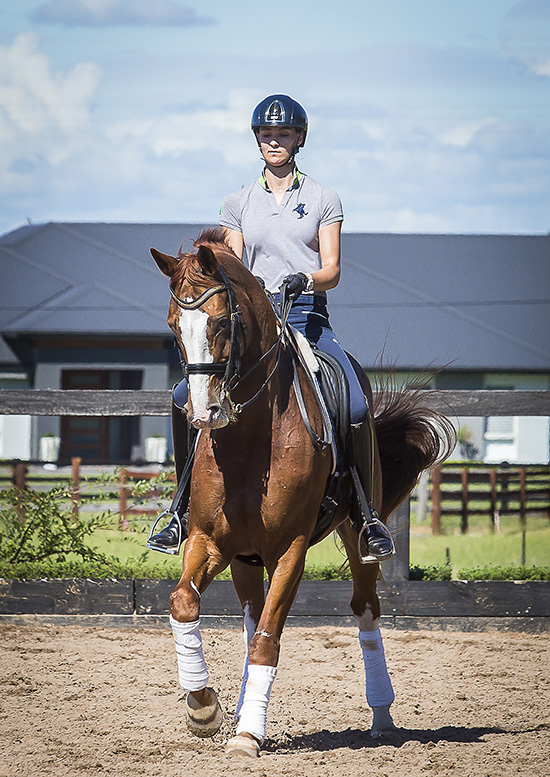
“Canter trot/ trot canter is where it shows if the horse is in front of the leg. That’s why that silly canter to trot transition is at the end of the Grand Prix test. It shows the judges where the horse is at. I think it should have a coefficient of 3 or 4! You don’t want him to get tight to the leg when he reacts.”
Diamond Star was getting softer and allowing Sally to ride him more, “You want the saddle to drop into his back not that he pushes the saddle away. Now the back starts working, the neck starts working, the ribs start working. That’s good. He should let your aids in. So you want him to get quick, but stay supple.”
The pair were then executing some canter half passes and Stefan wanted Sally to improve the half pass with other exercises, “The canter got a bit funky there. Again. That’s better. Never do the same movement over and over. Do some simple movements like canter to trot and walk breaks.
“After a walk break, close your legs see what happens. Activity good, suppleness not so good. Relax your wrist a bit more. Let the horse straighten your wrist and have the feeling that he takes it away from your arm a little. Your arm does not have to give but let it be more passive.”
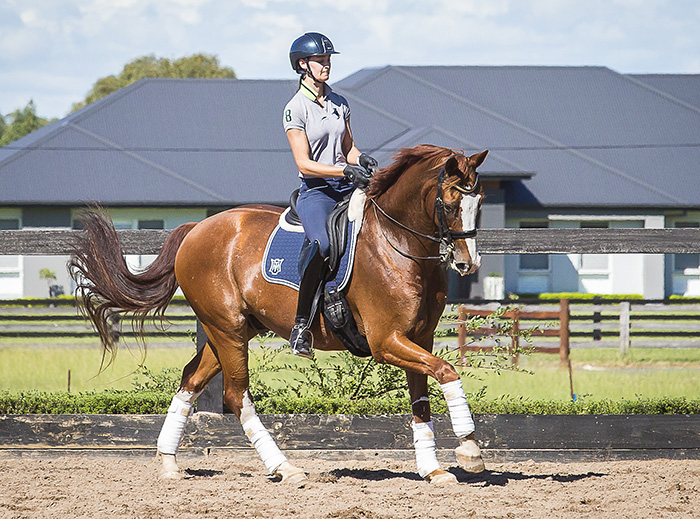
“Now half halt, a touch more collection but the same way through the body. With him you don’t have to do anything with your hand, just make him more supple to your leg. You don’t need to ride the half pass steep, that’s easy when the horse is soft and in front of your leg. He needs to give with activity into your inside leg. Get a reaction. There you go. Exactly! Move your inside leg a little bit in the half pass. Let the horse lead your hand. It’s not giving so much as allowing the horse to take it into the half pass. Mix it up a bit in training, not the formal movements from the tests. If you lose his ribs, for example, go forward a couple of steps.”
After a break it’s time to begin the work for pirouettes and Stefan gives a great introduction, “Pirouette canter on the circle line.Don’t turn yet. Now he’s got too bouncy. Feel more that he brings his legs up into his body, not bounces off his legs. He needs to keep the saddle into his back. Let him fall to his inside hind leg. The outside shoulder goes to his inside hind leg. More dynamics. I want more happening. The more they are on the spot the harder that is, but that’s the challenge. So in the higher collection, there’s actually more going on, more what their muscles are doing. If the canter gets a bit wooden, just ride out of it. It happens to all of us. Don’t use the seat so much, from your leg more. Let him jump into the bit. Better. Walk. Good riding!”
The take home message? Pay attention to the little details.
next Grace is back with another young horse
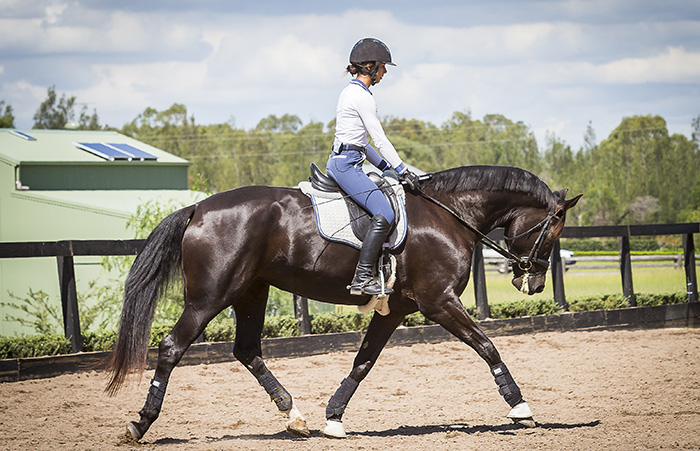
Grace is back in the arena, this time on the four-old-mare, Sonara, softly warming her up, “Get her to stretch. You don’t have to always let the stretch go through, it’s more that they offer the stretch and that in itself helps the back. Sometimes pat them after the whip so they know it’s normal. ‘I’m not punishing you I’m just trying to help your back.’When you use the whip now, find the movement where it’s easy for her to swing through your leg to the hand and soften the back. Sometimes they don’t know what to do with the energy created by the whip, that’s why they kick out. Can you see then she also reacted with the front leg? That’s good. The whole body should react. When you have a good reaction from the horse, always make them confident with it.”
The pair ride some 20 metre trot circles and five loop serpentines with Stefan looking for the same quality through both reins. “Just think of flexion as the giving in the inside gullet, not that it moves a lot sideways. It’s quality not quantity.”
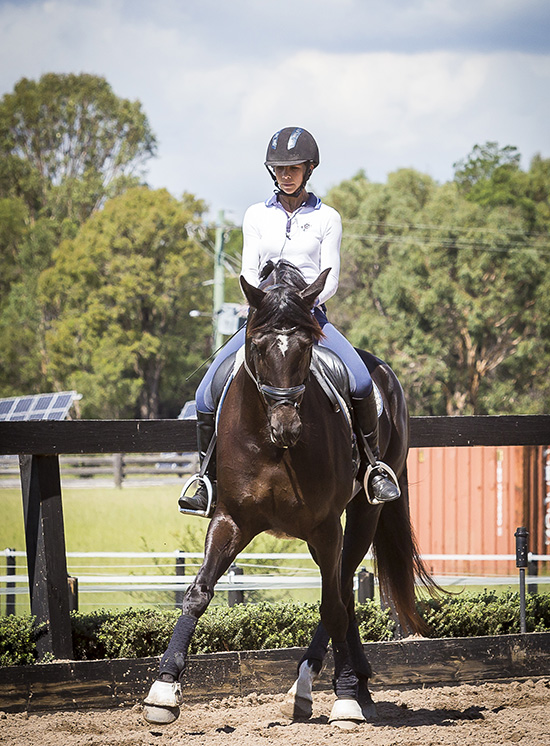
The main work then begins with some shoulder in, “Limit the bend of the shoulder and you automatically get more bend in the ribs.”Grace can easily correct any problem so soon the pair are playing with the half pass with Stefan encouraging, “Outside shoulder and more to the rib. Then she’s more on the leg and you can do something with it. Get her to accept the leg. Before the half pass, get her to give in that inside gullet to your inside rein. Keep her secure there. Good!”
After a walk break it’s time for the canter work with Stefan throwing out some reminders, “Don’t lose the shoulder. Not too much with the inside gullet. Remember it’s quality not quantity. The energy still has to go through the neck. Ten metre circle on the long side. Get the outside shoulder first so you can give the inside rein and she can turn in front of you and lift her poll on the inside. Then she gives overall as well.”
The exercises develop into 10 metre circles off the centreline and counter canter down the long side. “Have the feeling you want to ride a circle through the fence. There, now you have the shoulder. You can control the outside shoulder and she takes the inside rein through the turn.”
“That’s super through the body now. Once you have the access to the horse, it’s easier.”
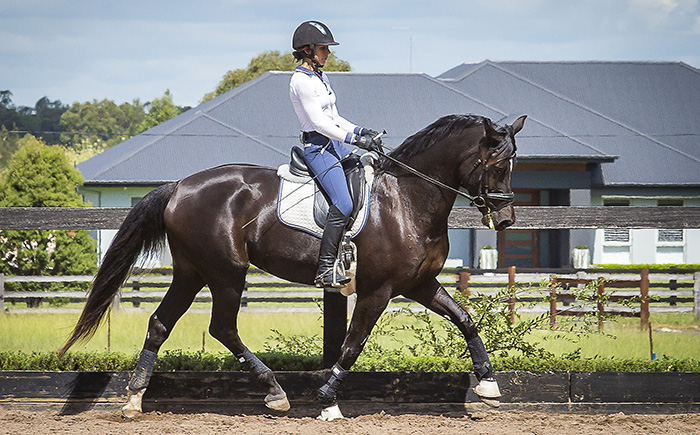
And that’s probably a good message to finish on, and one you see Stefan working on ‘through’ every lesson; getting the horse soft in the body, in front of the leg, making every aid from the rider count, so you have access to the whole horse. From there you can control the horse’s body subtly and the higher movements are achievable. Stefan is a thoughtful instructor and a brilliant communicator of his wealth of knowledge.
The latest European dressage bloodlines are available in Australian breeders for the 2024 season from International Horse Breeders – Go to www.ihb.com.au
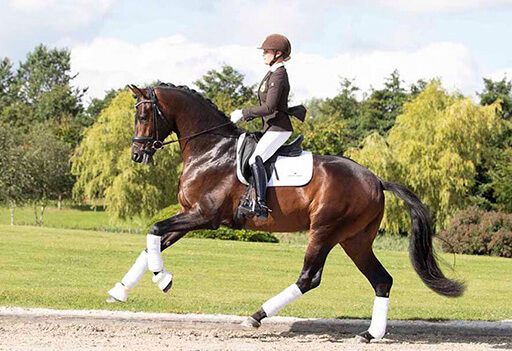
Dynamic Dream
Want to know more about dressage bloodlines? Which stallion would suit your mare? Here’s all the information you need…
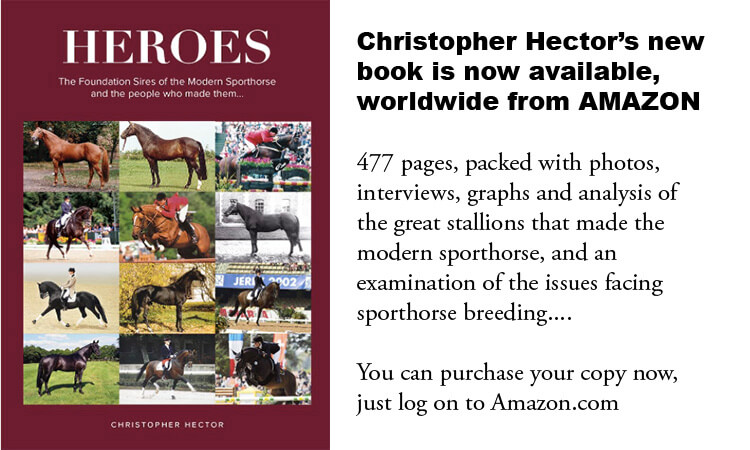


Very interesting read…. thanks for sharing and your report Chris, Going to ride some of these exercises ASAP.